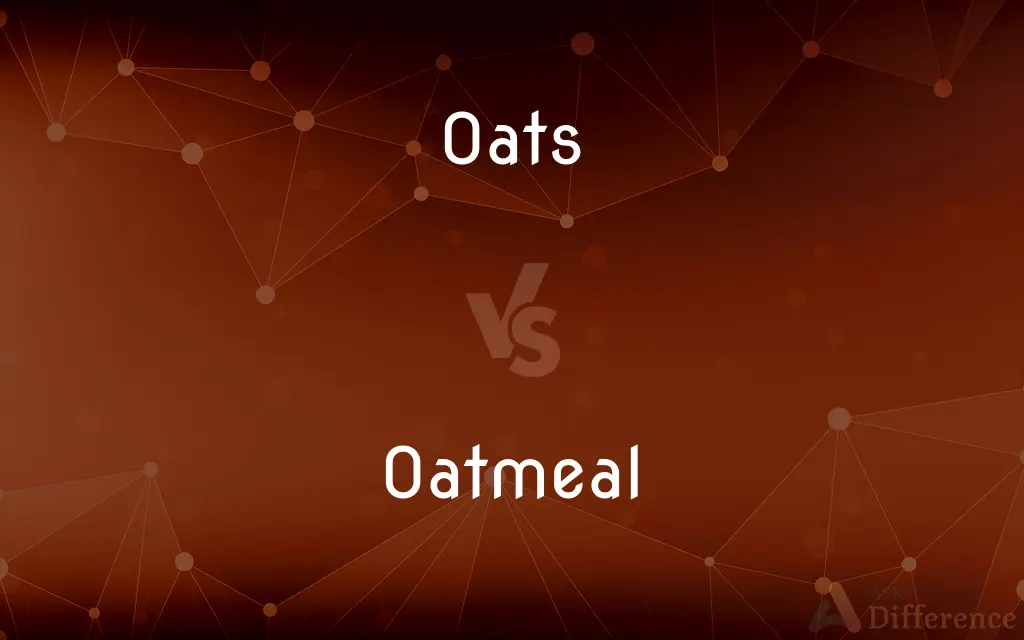Oats vs. Oatmeal — What's the Difference?
Edited by Tayyaba Rehman — By Urooj Arif — Updated on March 24, 2024
Oats are a grain used for food and feed, known for their health benefits, while oatmeal refers specifically to oats that have been processed (rolled, steel-cut, or ground) for cooking, typically as a hot breakfast cereal.

Difference Between Oats and Oatmeal
Table of Contents
ADVERTISEMENT
Key Differences
Oats are a type of cereal grain grown for their seed, belonging to the grass family, and are considered a staple in many diets due to their nutritional content, including high fiber, protein, and low glycemic index. Oatmeal, on the other hand, is a preparation of oats that have been dehusked, steamed, and flattened (rolled oats) or cut into pieces (steel-cut oats), or otherwise processed to reduce cooking time and enhance texture for consumption.
The primary distinction between oats and oatmeal lies in their form and the stage of processing. Oats in their raw, unprocessed form are not typically consumed by humans due to their hard texture and long cooking time. Whereas oatmeal, being pre-processed, is designed for quicker preparation, making it a convenient and healthy breakfast option.
Nutritionally, both oats and oatmeal offer similar benefits, as oatmeal is simply a processed form of oats. However, the degree of processing can affect the nutritional profile slightly, with less processed oats (like steel-cut oats) having a lower glycemic index compared to more heavily processed forms (like instant oatmeal).
The use of oats extends beyond oatmeal; oats are also used in baking, for brewing beer, and as livestock feed, showcasing their versatility. Oatmeal’s popularity, particularly in colder climates, comes from its warming properties and the ability to be flavored in numerous ways, making it a hearty breakfast choice.
In culinary terms, oats may also refer to the whole grain used in a variety of dishes, not just breakfast cereals. In contrast, oatmeal often specifies the dish made from oats, typically served warm and often sweetened or accompanied by fruits, nuts, or spices.
ADVERTISEMENT
Understanding the difference between oats and oatmeal is crucial for dietary planning and culinary uses, ensuring the correct form of this nutritious grain is used to achieve desired cooking and nutritional outcomes.
Comparison Chart
Definition
Whole grain seeds of the oat plant.
Processed oats ready for cooking, often as porridge.
Processing
Minimal; primarily cleaning and hulling.
Processed (rolled, steel-cut, or ground) for easier cooking and consumption.
Nutritional Value
High in fiber, protein, vitamins, and minerals.
Similar to oats, but processing level can affect glycemic index and fiber content.
Cooking Time
Longer cooking time if used directly from raw form.
Shorter cooking time due to pre-processing.
Culinary Uses
Used in various forms: whole, rolled, steel-cut, flour.
Primarily consumed as a hot breakfast cereal or porridge.
Versatility
Used in baking, brewing, and as livestock feed.
Mostly limited to breakfast dishes and snacks.
Compare with Definitions
Oats
High in nutritional value.
Oats are a good source of soluble fiber.
Oatmeal
A staple in colder climates.
Oatmeal is a warming meal during winter months.
Oats
Consumed after minimal processing.
Whole oats are often used in granola.
Oatmeal
Customizable with various toppings.
Oatmeal topped with berries and nuts is a nutritious breakfast choice.
Oats
A cereal grain grown for its seed.
Farmers rotate their crops between wheat and oats.
Oatmeal
Processed oats intended for quick cooking.
Instant oatmeal packs are convenient for a quick breakfast.
Oats
Used beyond human consumption.
Oats serve as an important livestock feed.
Oatmeal
Often eaten as porridge.
Oatmeal is traditionally served warm with milk or water.
Oats
Versatile in culinary uses.
Oats are incorporated into bread for added texture.
Oatmeal
May have a varied glycemic index.
Instant oatmeal has a higher glycemic index than steel-cut oats.
Oats
Any of various grasses of the genus Avena, especially A. sativa, widely cultivated for their edible grains.
Oatmeal
Oatmeal refers to a preparation of oats that have been dehusked, steamed and flattened, or else a coarse flour made of hulled oat grains (groats) that have either been milled (ground) or steel-cut. Ground oats are also called "white oats".
Oats
The grain of any of these plants, used as food and fodder.
Oatmeal
Meal that is made from oats; rolled or ground oats.
Oats
A musical pipe made of an oat straw.
Oatmeal
A porridge that is made from rolled or ground oats.
Oats
Plural of oat
Oatmeal
Meal made from rolled or round oats.
Oats
A mass of oat plants (genus Avena, especially Avena sativa).
Oats are in the north corner of the farm.
Usually oats is last in a rotation and does not get the fertilizer that other feed grains get.
Oatmeal
A breakfast cereal made from rolled oats, cooked in milk and/or water.
Oats
Seeds of an oat plant, especially prepared as food.
Oats is a heart-healthy breakfast food.
Oats are good for you.
Oatmeal
A light greyish brown colour, like that of oatmeal.
Oatmeal
Of a light greyish brown colour, like that of oatmeal
Oatmeal
Meal made of oats.
Oatmeal
A plant of the genus Panicum; panic grass.
Oatmeal
Porridge made of rolled oats
Oatmeal
Meal made from rolled or ground oats
Common Curiosities
Is oatmeal good for losing weight?
Yes, oatmeal can be part of a weight loss diet due to its high fiber content, which helps in feeling full longer.
What is the healthiest form of oatmeal?
Steel-cut oats are considered healthier due to their lower glycemic index and higher fiber content compared to more processed forms.
Do oats and oatmeal taste the same?
The taste is similar, but the texture and preparation method can affect the final flavor profile of oatmeal compared to whole oats.
What makes oatmeal a comfort food?
Oatmeal is considered a comfort food due to its warm, creamy texture and the ability to add various comforting flavors.
What's the difference in cooking time between oats and oatmeal?
Raw oats generally require longer cooking times, while processed oatmeal is designed for quick or instant preparation.
Why is oatmeal recommended for breakfast?
Oatmeal is recommended for breakfast due to its nutritional profile, providing energy and keeping you full until lunch.
How can you enhance the flavor of oatmeal?
Enhancing oatmeal’s flavor can be done by adding fruits, nuts, spices like cinnamon, or sweeteners like honey or maple syrup.
Are oats gluten-free?
Oats are naturally gluten-free, but they can be contaminated with gluten from other grains during processing unless specifically labeled as gluten-free.
Can oatmeal help with digestion?
Yes, the high fiber content in oatmeal can aid in digestion and prevent constipation.
How do oats become oatmeal?
Oats become oatmeal through processes like rolling, cutting, or grinding, which makes them suitable for quicker cooking.
Can oats be eaten without cooking?
Yes, oats like rolled oats can be eaten without cooking, often soaked overnight in milk or yogurt, known as overnight oats.
Can you substitute oats for oatmeal in recipes?
Depending on the recipe, oats can often be substituted for oatmeal, especially if the texture difference is considered.
What's the environmental impact of growing oats?
Oats have a relatively low environmental impact compared to some other crops, often used in sustainable farming practices.
Is there a difference in shelf life between oats and oatmeal?
Processed oatmeal may have a slightly longer shelf life due to its dry processing, but both generally have good shelf stability when stored properly.
How does the nutritional content of oats contribute to heart health?
The soluble fiber in oats can help lower cholesterol levels, contributing to improved heart health.
Share Your Discovery

Previous Comparison
Bigot vs. Racist
Next Comparison
Contract vs. ExpandAuthor Spotlight
Written by
Urooj ArifUrooj is a skilled content writer at Ask Difference, known for her exceptional ability to simplify complex topics into engaging and informative content. With a passion for research and a flair for clear, concise writing, she consistently delivers articles that resonate with our diverse audience.
Edited by
Tayyaba RehmanTayyaba Rehman is a distinguished writer, currently serving as a primary contributor to askdifference.com. As a researcher in semantics and etymology, Tayyaba's passion for the complexity of languages and their distinctions has found a perfect home on the platform. Tayyaba delves into the intricacies of language, distinguishing between commonly confused words and phrases, thereby providing clarity for readers worldwide.














































